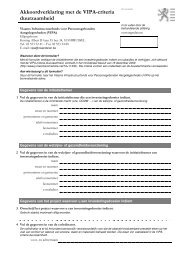2008-12-15-svr-rapport2008-4 - Vlaanderen.be
2008-12-15-svr-rapport2008-4 - Vlaanderen.be
2008-12-15-svr-rapport2008-4 - Vlaanderen.be
Create successful ePaper yourself
Turn your PDF publications into a flip-book with our unique Google optimized e-Paper software.
Figuur 1 Overzicht van de verschillen tussen government governance<br />
en corporate governance<br />
Belangrijke verschillen tussen government governance en corporate governance<br />
government governance corporate governance<br />
allocatie van goederen en diensten politieke <strong>be</strong>sluitvorming<br />
markt<br />
doelstellingen maatschappelijk • winstmaximalisatie<br />
aard doelstellingen<br />
niet altijd tastbaar; kwalitatief;<br />
veranderlijk<br />
randvoorwaarden • rechtmatigheid<br />
gerichtheid toezicht<br />
• efficiency<br />
• effectiviteit<br />
• tijdigheid<br />
• integriteit<br />
• doorzichtigheid<br />
• uitvoerbaarheid<br />
• controleerbaarheid<br />
voorschriften, structuren, processen<br />
gericht op het operationaliseren van<br />
doelstellingen<br />
• waarde onderneming<br />
• continuïteit<br />
helder; kwantitatief; vast<br />
maatschappelijke factoren<br />
doelstellingen<br />
gerichtheid <strong>be</strong>stuurders ‘plan and do’ ‘check and action’<br />
Bron: Directie Accountancy Rijksoverheid, 2000, 9<br />
Edwards en Clough (2005, 2) definiëren “corporate governance” als volgt: ‘I generally define<br />
corporate governance to encompass how an organisation is managed, its corporate and<br />
other structures, its culture, its policies and strategies, and the ways in which it deals with<br />
its various stakeholders. 3 (Barrett 2002, 2)’. Corporate governance omvat naar hun mening<br />
twee dimensies: “performance” en “conformance”. “Performance” omvat de monitoring van<br />
performantie, strategie (doeleinden formuleren en strategie om ze te realiseren), het<br />
responsief zijn voor een veranderende omgeving en het risicomanagement. Dit is op zich<br />
een heel ruime omschrijving, maar niettemin staat de performantie centraal. Met<br />
“conformance” doelt men op de instemming met regelgeving en diverse standaarden alsook<br />
de “accountability” t.o.v. stakeholders.<br />
Vervolgens staan we stil bij de definitie en invulling die men geeft aan het concept “good<br />
governance” als dusdanig. Wat verstaat men onder dit <strong>be</strong>grip en welke accenten legt men?<br />
Een bruikbare definitie vinden we terug bij de Wereldbank: ‘...the manner in which public<br />
officials and institutions acquire and exercise the authority to shape public policy and<br />
provide public goods and services’ (Worldbank, 2007). Het is duidelijk dat men hier opteert<br />
voor wat Leftwich (1993) een politieke <strong>be</strong>nadering van het <strong>be</strong>grip noemt.<br />
Naar aanleiding van hun studie omtrent indicatoren van governance werd deze definitie<br />
specifieker gemaakt : "...the traditions and institutions by which authority in a country is<br />
exercised. This includes the process by which governments are selected, monitored and<br />
replaced; the capacity of the government to effectively formulate and implement sound<br />
policies; and the respect of citizens and the state for the institutions that govern economic<br />
3 Public sector stakeholders include: clients, ministers, local communities, inter-government agencies, other levels<br />
of government, business/industry representatives, NGOs, community and private partnership agencies, private<br />
contractors and academics.<br />
4 / Good governance Studiedienst van de Vlaamse Regering

















